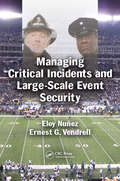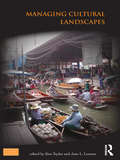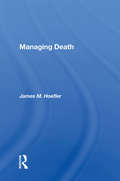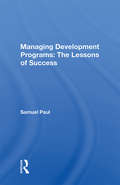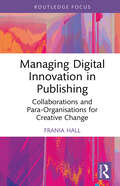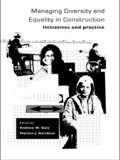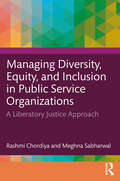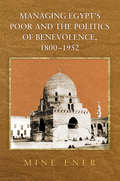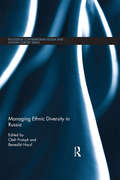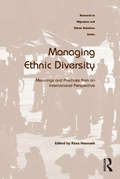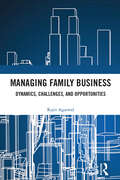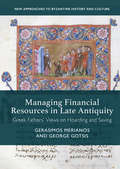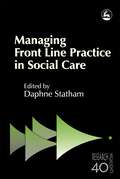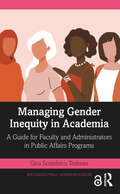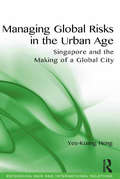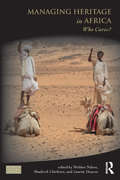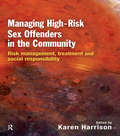- Table View
- List View
Managing Critical Incidents and Large-Scale Event Security
by Eloy Nuñez Ernest G. Vendrell2017 Award Winner of the ASIS Security Book of the Year Nuñez and Vendrell aim to provide the most current and effective resources for managing special events and critical incidents. Their book relies heavily on case studies and after action reports that examine the lessons learned from a multitude of previous events and incidents. In addition, the text identifies and examines best practices and recommended approaches, providing the reader with a variety of checklists and planning tools.
Managing Cultural Landscapes (Key Issues in Cultural Heritage)
by Ken Taylor Jane L. LennonOne of our deepest needs is for a sense of identity and belonging. A common feature in this is human attachment to landscape and how we find identity in landscape and place. The late 1980s and early 1990s saw a remarkable flowering of interest in, and understanding of, cultural landscapes. With these came a challenge to the 1960s and 1970s concept of heritage concentrating on great monuments and archaeological locations, famous architectural ensembles, or historic sites with connections to the rich and famous. Managing Cultural Landscapes explores the latest thought in landscape and place by: airing critical discussion of key issues in cultural landscapes through accessible accounts of how the concept of cultural landscape applies in diverse contexts across the globe and is inextricably tied to notions of living history where landscape itself is a rich social history record widening the notion that landscape only involves rural settings to embrace historic urban landscapes/townscapes examining critical issues of identity, maintenance of traditional skills and knowledge bases in the face of globalization, and new technologies fostering international debate with interdisciplinary appeal to provide a critical text for academics, students, practitioners, and informed community organizations discussing how the cultural landscape concept can be a useful management tool relative to current issues and challenges. With contributions from an international group of authors, Managing Cultural Landscapes provides an examination of the management of heritage values of cultural landscapes from Australia, Japan, China, USA, Canada, Thailand, Indonesia, Pacific Islands, India and the Philippines; it reviews critically the factors behind the removal of Dresden and its cultural landscape from World Heritage listing and gives an overview of Historic Urban Landscape thinking.
Managing Death
by James M. HoeflerMany Americans, before they die, will go through a stage where they are unable to make competent decisions about their own life-sustaining medical treatment. More and more, family members and care givers are facing these difficult decisions in their stead, becoming engulfed in questions about personal wishes, medical ethics, state and federal law, and quality of life. Drawing on provocative case studies, personal interviews, and detailed research, James Hoefler examines the medical, legal, ethical, and clinical aspects of such right-to-die issues. Beginning with the legal struggle of a woman whose son existed in a persistent vegetative state (PVS) for seventeen years, the author moves into a broader look at consensus among professional organizations, from the AMA to the President's Commission to the National Center for State Courts; beliefs of mainstream religious groups; public opinion; issues surrounding end-stage Alzheimer's and other organic brain disorders that can slowly lead to PVS; and the role of artificial nutrition and hydration in these cases. Hoefler concludes with recommendations on how to improve the quality of right-to-die decision making. An absorbing read with a minimum of technical jargon, this book is a valuable guide to care givers, public policy students, medical ethicists, family members, and anyone facing questions about an individual's right to die.
Managing Death: International Perspectives
by Neil Thompson Gerry R. CoxThere is a huge collection of literature relating to death, grief and bereavement, but one aspect that has received relatively little attention is that of death management practices (by which we mean the various ways of managing the circumstances of the death, ritually acknowledging it and sensitively handling the disposal of the body and so on). While ways of disposing of the dead and grief practices have been thought of as based upon individual responses, grief and bereavement practices can be understood not only by looking at psychological and medical frameworks, but also by examining people as part of a complex structure of social arrangements, institutions, structures, and patterns. By examining the social and institutional structures of various groups around the world, we provide an international framework for a better understanding of the study of dying, death, and bereavement.This book highlights the significance of these matters in an international context, reflecting common themes and important differences. It will highlight common themes across diverse cultures and national settings, while also drawing attention to significant differences. If professionals working in the field of death, grief and bereavement are not aware of such differences, their practice can be insensitive, discriminatory and therefore ineffective, if not actually counterproductive. As such, the book provides an invaluable resource for a wide variety of professionals and students, including medicine and health care; social work; counselling and psychotherapy; chaplaincy and pastoral work; and, of course, those involved in the funeral industry. In addition, students of sociology, psychology and anthropology will find much of interest here in terms of appreciating the diversity of ways in which funerals and other death management practices are managed and integrated into social life.
Managing Development In The Third World
by Coralie BryantThis is the first text to focus on the problems and processes involved in organizing, implementing, and managing programs and projects aimed at relieving poverty and underdevelopment in the Third World. During the 1970s there was a shift in development assistance programs toward a greater concern for equity and the basic needs of the poor. The auth
Managing Development Programs: The Lessons Of Success
by Samuel PaulThis book explores a neglected dimension - the role of management interventions in development programs. It investigates two basic questions: what are the management and institutional interventions associated with successful development programs? what lessons can we learn from their experience?
Managing Digital Innovation in Publishing: Collaborations and Para-Organisations for Creative Change
by Frania HallReflecting proactively on a growing industry 'dilemma', this book explores how publishing businesses can and do successfully experiment and innovate in digital publishing through collaboration.Many sectors of publishing are still structured around print production, with digital innovation in the consumer arena generally focused on different book formats, such e-books and audiobooks, rather than on brand-new types of products. Publishers need to innovate around different sorts of content and digital formats as consumers change their media habits. However, their pricing, business and risk models, and workflows are reflective of a legacy of print publishing; and as print commands so much revenue, publishers do not want to derail their main business as they experiment. Drawing on an analysis of collaboration and network theory and four in-depth qualitative case studies in different sectors, this research suggests that collaboration, particularly engaging with the wider creative sector, is key to the sustainable development of new types of products. It points to the characteristics of a successful digital collaboration and explains how to manage publishing innovation alongside the existing business, through para-organisations. Considering novel approaches to innovation, such as iterative software-style approaches and agile project management, as well as new business models, such as those employed in games development, the author shows how introducing new people – from software developers to competitors – can help instill a collaborative mindset within the organisation and facilitate constructive experimentation.Managing Digital Innovation in Publishing will be of interest to upper-level students and researchers of (digital) publishing and related creative industries.
Managing Diversity and Equality in Construction: Initiatives and Practice
by Marilyn J. Davidson Andrew W. GaleWith women in the UK construction industry constituting just thirteen per cent of the workforce and black and Asian workers numbering less that two per cent, despite representing more than six per cent of the working population, diversity is a problem that the construction industry needs to tackle directly. In this title, diversity management is presented as an opportunity for the construction industry. Work is presented from several different countries and regions, in North America, Australia and Europe to provide a comprehensive picture of this complex and often sensitive issue. Going beyond the traditional topics of gender and racial discrimination contributions encompass a wide range of diversity issues facing the construction industry, including sexual orientation, disability and the work-life balance. Essential reading for construction managers and a valuable resource for post-graduate researchers, this key title provides not only a thorough exposition of contemporary research but also supplies the practical diagnostic tools, and techniques to successfully manage diversity in construction and the information to adhere to the law.
Managing Diversity, Equity, and Inclusion in Public Service Organizations: A Liberatory Justice Approach
by Meghna Sabharwal Rashmi ChordiyaManaging Diversity, Equity, and Inclusion in Public Service Organizations: A Liberatory Justice Approach is a textbook designed to facilitate critical and courageous conversations that recognize our differences, including our privileged and marginalized social identities, and engage readers in the principles and practice of solidarity to transform systems of oppression. Examining dimensions of race, gender, sexual orientation, disabilities, and their intersectionality in the context of diverse, multigenerational organizations, this leading-edge new textbook redefines and reimagines the role of public service in fostering meaningful, authentic, sustainable, and transformative change.While diversity is now a standard topic in books on public personnel and human resource management, authors Rashmi Chordiya and Meghna Sabharwal offer a deeper, nuanced, and reflective understanding of many of the systematic and often covert ways in which marginalized and minoritized groups can face barriers to full and equal participation in decision-making, access to resources, and opportunities for advancement and growth. Taking a holistic, liberatory public service approach, the book explores what it would mean if public service systems were reimagined, and goals aligned and transformed, to serve an “all means all” public.Other unique features of this book include developing a nuanced understanding of trauma of oppression from neurobiological, sociological, and historical perspectives. This book supports the reader in exploring ways of cultivating individual and organizational competencies and capacities for envisioning and implementing trauma-informed, repair and healing-centered approaches to public service that compassionately center the margins. To encourage learner engagement and to connect theory to practice, this book offers several case studies. Each chapter contains a description of big ideas, big questions, and key concepts and teachings offered in that chapter, as well as chapter summaries and deep dive resources. Throughout the book, the authors offer boxed invitations to pause and use reflective prompts to engage readers with the core concepts and key teachings of the book. Managing Diversity, Equity, and Inclusion in Public Service Organizations is required reading for all current and future public administrators and nonprofit leaders.
Managing Egypt's Poor and the Politics of Benevolence, 1800-1952
by Mine EnerThis richly textured social history recovers the voices and experiences of poor Egyptians--beggars, foundlings, the sick and maimed--giving them a history for the first time. As Mine Ener tells their fascinating stories alongside those of reformers, tourists, politicians, and philanthropists, she explores the economic, political, and colonial context that shaped poverty policy for a century and a half. While poverty and poverty relief have been extensively studied in the North American and European contexts, there has been little research done on the issue for the Middle East--and scant comprehensive presentation of the Islamic ethos that has guided charitable action in the region. Drawing on British and Egyptian archival sources, Ener documents transformations in poor relief, changing attitudes toward the public poor, the entrance of new state and private actors in the field of charity, the motivations behind their efforts, and the poor's use of programs created to help them. She also fosters a dialogue between Middle Eastern studies and those who study poverty relief elsewhere by explicitly comparing Egypt's poor relief to policies in Istanbul and also Western Europe, Russia, and North America. Heralding a new kind of research into how societies care for the destitute--and into the religious prerogatives that guide them--this book is one of the first in-depth studies of charity and philanthropy in a region whose social problems have never been of greater interest to the West.
Managing Emotions in Journalism: A Guide to Enhancing Resilience
by Maja ŠimunjakThis textbook offers the first practical guide to managing emotions in everyday journalism work based on interviews with more than 30 British journalists. It raises awareness of emotional situations and stressors journalists may face, so practitioners are better able to recognise these and prepare for them, and outlines practical emotion management strategies which they can apply to enhance their emotional intelligence and resilience and consequently, feel and perform better in the workplace. It includes vignettes written by journalists from the United Kingdom, United States, Australia and Croatia, as well as practical scenario exercises that prompt readers to reflect on how they would feel and react in specific situations based on journalists’ everyday work.
Managing Environmental Pollution (Routledge Environmental Management)
by Andrew FarmerPresents a comprehensive introduction to the nature of pollution, its impact on the environment, and the practical options and regulatory frameworks for pollution control. Sources of pollution, regulatory controls, technological solutions, management and mitigation techniques and assessment tools, are examined in each key area: air, freshwater, and marine pollution, contaminated land and radioactive substances. Illustrated with a worldwide range of case examples this book offers an invaluable up-to-date guide to both the principles and practice of pollution management.
Managing Environments for Leisure and Recreation
by Richard BroadhurstCan we balance the needs of the host, the environment and the visitor?Most people live for their leisure, recreation and travel opportunities. Managing Environments for Leisure and Recreation seeks to bring together the different strands of thought that inform the management of settings, for leisure and recreation. The text shows how a positive difference can be made to such activities, by taking a balanced approach in managing for the environment and for people, both now, and into the future.Managing Environments for Leisure and Recreation urges managers to balance the need for a systematic approach, with the need for a systemic development of an environmental management ethic. It is highly illustrated with over 50 line drawings and includes many case studies from around the world.
Managing Ethnic Diversity in Russia (Routledge Contemporary Russia and Eastern Europe Series)
by Oleh Protsyk Benedikt HarzlThis book provides a comprehensive overview of the norms and practices of ethnic diversity management in the Russian Federation in the last twenty years. It examines the evolution of the legal framework, the institutional architecture and the policies intended to address the large number of challenges posed by Russia’s immense ethno-cultural diversity. It analyses the legal, social and political changes affecting ethno-cultural relations and the treatment of ethnic minorities, and assesses how ethnic diversity both influences and is shaped by transformations in Russian politics and society. It concludes by appraising how successful or otherwise policies have been so far, and by outlining the challenges still faced by the Russian Federation.
Managing Ethnic Diversity: Meanings and Practices from an International Perspective (Research In Migration And Ethnic Relations Ser.)
by Reza HasmathThe management of ethnic diversity has become a topical and often controversial subject in recent times, with much debate surrounding multiculturalism as a systematic and comprehensive response for dealing with ethnic diversity. This book engages with these debates, examining the tangible outcomes of multiculturalism as a policy and philosophy in a range of traditional and 'newer' multi-ethnic nations. Exploring the questions of whether multiculturalism can promote 'ethnic harmony', employment equity and trust between various minority and non-minority groups, Managing Ethnic Diversity also adopts a comparative perspective on the experiences of multiculturalism in various international contexts, in order to examine whether lessons learned from some jurisdictions can be applied to others. With an international team of experts presenting the latest research from the UK, North America, Europe, China and Australasia, a truly global dialogue is fostered with regard to the utility and limits of multiculturalism in local and comparative contexts. As such, Managing Ethnic Diversity will appeal to social scientists interested in race and ethnicity, multiculturalism and migration.
Managing Expatriates in China
by Anne-Wil Harzing Ling Eleanor Zhang Shea Xuejiao FanProviding fresh perspectives on managing expatriates in the changing host country of China, this book investigates expatriate management from a language and identity angle. The authors' multilingual and multicultural backgrounds allow them to offer a solid view on the best practices towards managing diverse groups of expatriates, including Western, Indian, and ethnic Chinese employees. With carefully considered analysis which incorporates micro and macro perspectives, together with indigenous Chinese and Western viewpoints, this book explores topics that include the importance of the host country language, expatriate adjustment, ethnic identity confirmation, acceptance and identity. The book presents a longitudinal yet contemporary snapshot of the language, culture, and identity realities that multinational corporation subsidiary employees are facing in China in the present decade (2006-2016). It will thus be an invaluable resource for International Management scholars, those involved in HRM and other practitioners, as well as business school lecturers and students with a strong interest in China.
Managing Family Business: Dynamics, Challenges, and Opportunities
by Rajiv AgarwalThis book explores the unique characteristics and complexities of family businesses in India. It examines the intersection of family dynamics, cultural norms, and business practices, to offer valuable insights on how family businesses evolve, develop, grow, and sustain over time. With a focus on leadership and positioning for the future, this book illustrates how the family enterprise can achieve sustained growth and continuity through generations. Covering a wide range of topics essential for understanding the Indian family business landscape, this volume: Studies succession planning and governance, managing family conflicts and harnessing innovation Analyses the various strengths and weaknesses of family businesses Shares insights on top-performing family businesses alongside the oldest businesses in India and across the world Emphasises and extensively discusses the role of women in the contemporary Indian business landscape Insightful and engaging, this book will be useful to students, researchers, and teachers in the fields of business management, commerce, and economics. It will also be an invaluable resource for present or potential family business owners, managers, professionals, and business consultants.
Managing Family Business: Dynamics, Challenges, and Opportunities
by Rajiv AgarwalThis book explores the unique characteristics and complexities of family businesses in India. It examines the intersection of family dynamics, cultural norms, and business practices to offer valuable insights on how family businesses evolve, develop, grow, and sustain over time. With a focus on leadership and positioning for the future, this book illustrates how the family enterprise can achieve sustained growth and continuity through generations.Covering a wide range of topics essential for understanding the Indian family business landscape, this volume: Studies succession planning and governance, managing family conflicts and harnessing innovation Analyses the various strengths and weaknesses of family businesses Shares insights on top-performing family businesses alongside the oldest businesses in India and across the world Emphasises and extensively discusses the role of women in the contemporary Indian business landscape Insightful and engaging, this book will be useful to students, researchers, and teachers in the fields of business management, commerce, and economics. It will also be an invaluable resource for present or potential family business owners, managers, professionals, and business consultants.
Managing Famine, Flood and Earthquake in China: Tianjin, 1958-85 (Routledge Studies in the Modern History of Asia)
by Lauri PaltemaaChina suffers frequently from many types of natural disasters, which have affected the lives of many millions of Chinese. The steps which the Chinese state has taken to prevent disasters, mitigate their consequences, and reconstruct in the aftermath of disasters are therefore key issues. This book examines the single metropolis of Tianjin in northern China, a city which has suffered particularly badly from natural disasters – the great famine of 1958-61, the great flood of 1963 and the great earthquake of 1976. It discusses how the city managed these disasters, what policies and measures were taken to prevent and mitigate disasters, and to promote reconstruction afterwards. It also explores who suffered from and who benefited from the disasters. Overall, the book shows how disaster management was erratic, sometimes managed highly efficiently and in other cases disappointingly delayed and inept. It concludes that, although the Maoist state possessed formidable resources, disaster management was always constrained by other political and economic considerations, and was never an automatic priority.
Managing Financial Resources in Late Antiquity: Greek Fathers' Views On Hoarding And Saving (New Approaches To Byzantine History And Culture Ser.)
by George Gotsis Gerasimos MerianosThis book examines the views of Greek Church Fathers on hoarding, saving, and management of economic surplus, and their development primarily in urban centres of the Eastern Mediterranean, from the late first to the fifth century. The study shows how the approaches of Greek Fathers, such as Clement of Alexandria, Basil of Caesarea, John Chrysostom, Isidore of Pelusium, and Theodoret of Cyrrhus, to hoarding and saving intertwined with stances toward the moral and social obligations of the wealthy. It also demonstrates how these Fathers responded to conditions and practices in urban economic environments characterized by sharp inequalities. Their attitudes reflect the gradual widening of Christian congregations, but also the consequences of the socio-economic evolution of the late antique Eastern Roman Empire. Among the issues discussed in the book are the justification of wealth, alternatives to hoarding, and the reception of patristic views by contemporaries.
Managing Front Line Practice in Social Care
by Peter Beresford Daphne Statham Suzy CroftWritten by key figures in the field of social care training and management this much-needed book provides practice guidance for front line managers in social care. Refocusing attention on the management of practice and accountability within services and to service users, the authors provide a variety of perspectives on how front line managers can support practice. Highlighting important aspects of management, such as promoting knowledge-based practice and continuous professional development through lifelong learning, they discuss major issues such as: * setting and monitoring new standards and frameworks * what different communities want from social services * implications of the gender imbalance in social work management * bullying and harassment in the work environment * managing multidisciplinary teams. Drawing together important research on management practice, this book will ensure front line managers are prepared for shifts in policy, making it an essential resource for managers and policy makers in all areas of social care.
Managing Gender Inequity in Academia: A Guide for Faculty and Administrators in Public Affairs Programs (Routledge Public Affairs Education)
by Gina Scutelnicu TodoranAcademia is not immune to gender bias, and in many public affairs programs, inequities persist in faculty academic rank, salary, career length, job security, leadership roles, professional recognition, resource allocation, and role stereotypes. Managing Gender Inequity in Academia is the first book to provide an evidence-based guide for university administrators and faculty interested in building all-important gender equity in public affairs and related programs. Drawing on both secondary and primary data, the book offers a comprehensive perspective on public affairs faculty career paths, the obstacles to advancement in the academy, and how the COVID-19 pandemic further contributed to existing inequities.Each chapter of the book presents evidence-based research derived from interviews, surveys, existing statistics, and documents, offering guidance to public affairs programs, departments, and schools on ways to strengthen the recruitment, retention, and promotion of women in the academy. Ultimately, author Gina Scutelnicu Todoran demonstrates the ways in which gender equity can strengthen institutions of higher learning. Managing Gender Inequity in Academia is a guide for building gender equity in public affairs programs for faculty, higher education administrators, and graduate students in public affairs and related disciplines.Chapter 3 of this book is freely available as a downloadable Open Access PDF at http://www.taylorfrancis.com under a Creative Commons Attribution-Non Commercial-No Derivatives (CC-BY-NC-ND) 4.0 license.
Managing Global Risks in the Urban Age: Singapore and the Making of a Global City (Rethinking Asia and International Relations)
by Yee-Kuang HengThe first full-length exposition of what it terms a global city-global risks nexus, this volume crosses disciplinary boundaries to draw upon research from Security Studies; Geography; Sociology; and Urban Studies. Innovative in its approach integrating theories about Global Cities with those positing a Global Risk Society, Yee-Kuang Heng positions this research in the midst of two concurrent global trends that will gain more significance in coming years. The world is experiencing the consequences of not only rapid globalisation, but also urbanization. In 2008, the UN declared that more than half the world’s population was now urban. At the same time, highly connected global cities like New York, London, Tokyo and Singapore also face rapidly spreading global risks such as pandemics and financial crises. Unique in developing a typology of global risks that threaten a global city like Singapore, beyond its Asian focus, the book also draws out thematic and policy lessons pertinent to other global cities. ’Global cities’ do not simply materialize. They are dependent on a range of stakeholders at various levels that produce and re-produce its command and control capabilities, in the face of global risks. Singapore’s experiences managing global risks in the financial; aviation; and maritime domains are common concerns shared by many countries and cities that have, or aspire to develop, similar critical infrastructure.
Managing Heritage in Africa: Who Cares? (Key Issues in Cultural Heritage)
by Shadreck Chirikure Webber Ndoro Janette DeaconManaging Heritage in Africa provides a wide-ranging, up-to-date synthesis of heritage management practice in Africa, covering a broad spectrum of heritage issues such as archaeology, living traditions, sacred sites, heritage of pain (slavery), international conventions cultural landscapes, heritage in conflict areas and heritage versus development. Dealing with both intangible and tangible heritage, Managing Heritage in Africa gives an informative insight into some of the major issues and approaches to contemporary heritage management in Africa and situates the challenges facing heritage practitioners.
Managing High Risk Sex Offenders in the Community: Risk Management, Treatment and Social Responsibility
by Karen HarrisonSex offenders, and in particular paedophiles, have been the subject of much political and media attention, producing intensive debates about the best way of dealing with them. This book explores these issues, evaluating the measures in use or being considered, including drug treatment, MAPPA, the use of the Sex Offender Register, restorative justice techniques, and treatment programmes. It is concerned with high-risk sex offenders both when they are sentenced to a community order, and also when they are released back into the community after a custodial sentence. The introductory section opens with a discussion on how terms such as paedophilia are constructed and viewed, and then looks at how government policy regarding sex offending has developed over recent years. Section two looks at issues concerned with risk management, questioning whether enough is being done to monitor the risk that high-risk offenders pose when released into society; whilst section three, on risk reduction covers the main methods of treatment, including sex offender treatment programmes, pharmacotherapy (chemical castration) and restorative and reintegration techniques. Section Four focuses on specific offender groups; including female sexual offenders, sexual harm by youth, mentally disordered sexual offenders and intellectual disabled offenders. These assess in what ways these offenders are different to the 'norm' and look at how we should be dealing and treating these differences. The final section looks at social and moral responsibilities, including the patterns, prevention and protection of cyber-sex offences and media constructions of and reactions to paedophilia. In the final chapter the concept of dignity is addressed and the balance between community protection and the rights of sex offenders involved is evaluated.
